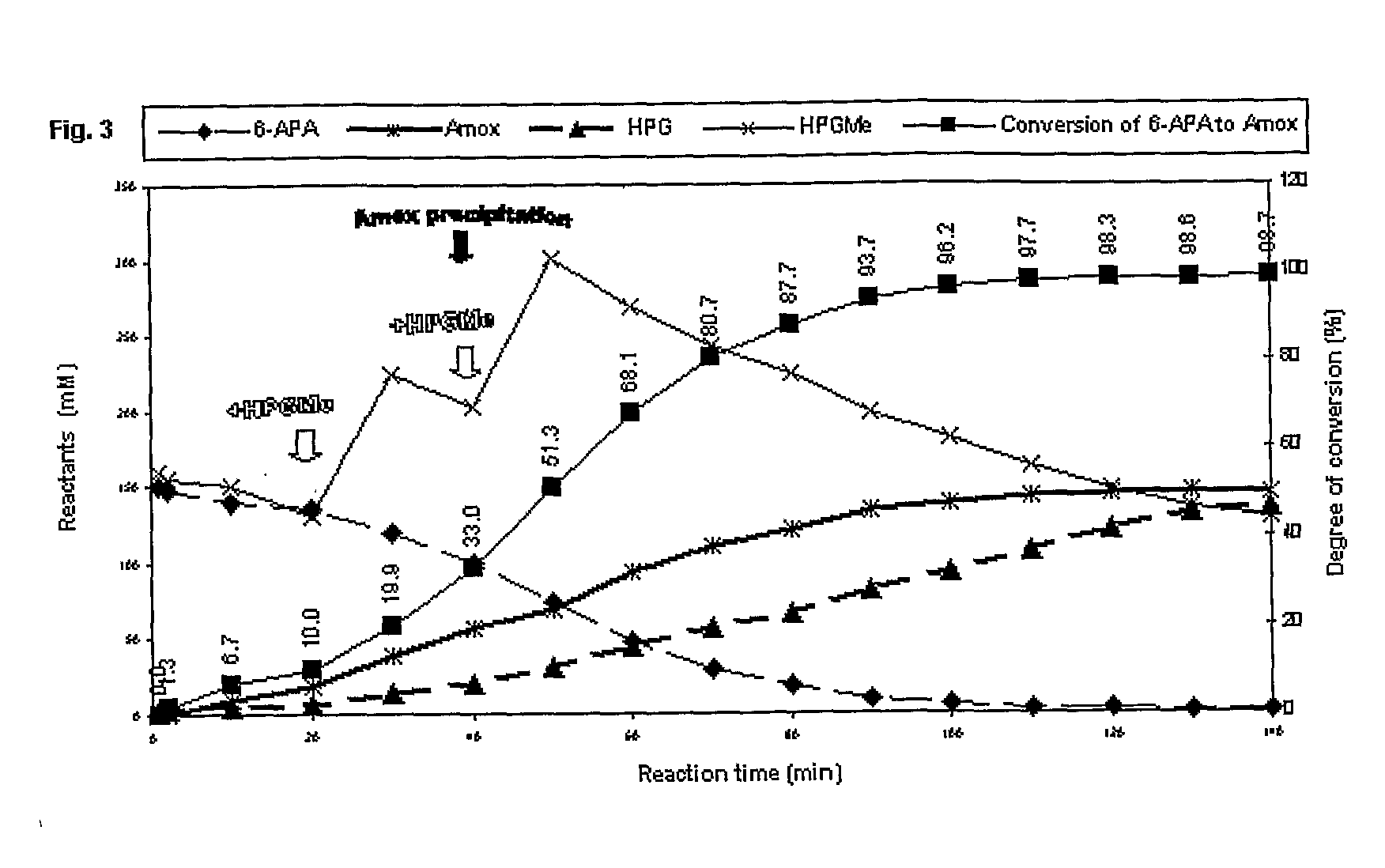Process for the preparation of immobilized recombinant penicillin acylase catalyst from achromobacter sp. ccm 4824 expressed in e. coli bl 21 ccm 7394 and its use for the synthesis of beta-lactam antibiotics
a technology of acylase catalyst and achromobacter sp., which is applied in the direction of fermentation, etc., can solve the problems of incomplete conversion of substrates to products, undocumented synthetic potential of these enzymes, and variants of i>e. coli /i>pa not giving the desired effect, and achieves the effect of improving yield
- Summary
- Abstract
- Description
- Claims
- Application Information
AI Technical Summary
Benefits of technology
Problems solved by technology
Method used
Image
Examples
example 1
Cell Lysis by High Pressure Homogeniser
[0120]E. coli BL 21 CCM 7394 cells with the activity of PA from Achromobacter sp.CCM 4824 were harvested from the culture broth by centrifugation in a form of cell paste (Sharples centrifuge) or in a form of cell suspension (Alfa-Laval continuous separator). The harvested biomass was suspended in 0.02M sodium phosphate to get about 5% (cdw / v) suspension pH of which was adjusted to 7.0 and maintained at this value with 20% w / v sodium hydroxide. Cell suspension (2350 ml, 4.9% cdw / v, AHPenG of 86.5 U / ml) cooled to 8-13° C. was subjected to disintegration (homogenizer Manton-Gaulin, pressure of 40-50 MPa, three consecutive cycles). After each cycle, the homogenate was cooled down to 8-13° C. and pH was adjusted to 7.0. The cell debris and a fraction of ballast proteins were removed by thermocoagulation step consisting in: pH adjustment to 5.0 with 50% acetic acid, addition of the flocculant Sedipur CL 930 (2-4 g / L) and maintaining the temperature a...
example 2
A. Enzyme Extraction by Mild Chemical Extraction
[0121]In another embodiment of invention, cell suspension (1050 ml, 5% cdw / v, AHPenG of 10.2 U / ml) was suspended in 0.1M sodium phosphate buffer (pH 7.5) at 20° C. A mild chemical lysis was carried out in three-necked glass reactor equipped with pH probe, temperature probe and variable agitator. After adjusting the pH to 7.0 with diluted ammonium hydroxide solution, the temperature was brought to 28° C. To this suspended biomass, 1% (v / v) of solvents like Toluene, Ethyl acetate, Chloroform, Butyl acetate was added to initiate cell lysis The reaction was monitored for change in pH at constant temperature. Samples were withdrawn periodically to estimate degree of cell lysis. The reaction was continued for 2 hrs at pH 7.0 and 28° C. The degree of lysis caused due to the solvent was measured by assaying AHPenG in supernatant of samples and comparing with initial activity of cell suspension (% cell lysis, Table 1).
TABLE 1ExperimentSolvents%...
example 3
Preparation of Enzyme Concentrate
[0126]350 gm of cell paste prepared as in Example 1 was suspended in distilled water to final concentration of 5% (cdw / v) at 20-25° C. The pH of the cell suspension was adjusted to 7.0 and ice cold 2% (v / v) Chloroform and 0.2% (w / v) Sodium lauryl sulfate was added to initiate lysis. Samples were withdrawn periodically during the total period of 5 hrs. The lysed biomass was further stored at 5° C. for 12 hrs before further processing to allow separation of protein from the ruptured cells. The temperature of the suspension was raised to 28-30° C. and diluted two fold with distilled water. The pH was adjusted to 5.0 with 2M acetic acid. Coagulation of acid protein from the suspension was done by adding 1% (w / v) of Polyethylene imine at 40° C. for one hour. The flocculated material was separated from the solution by centrifugation at 7000 rpm. The pH of clear supernatant was adjusted to 7.5 with 4N sodium hydroxide solution and obtained solution was desi...
PUM
 Login to View More
Login to View More Abstract
Description
Claims
Application Information
 Login to View More
Login to View More - R&D
- Intellectual Property
- Life Sciences
- Materials
- Tech Scout
- Unparalleled Data Quality
- Higher Quality Content
- 60% Fewer Hallucinations
Browse by: Latest US Patents, China's latest patents, Technical Efficacy Thesaurus, Application Domain, Technology Topic, Popular Technical Reports.
© 2025 PatSnap. All rights reserved.Legal|Privacy policy|Modern Slavery Act Transparency Statement|Sitemap|About US| Contact US: help@patsnap.com



